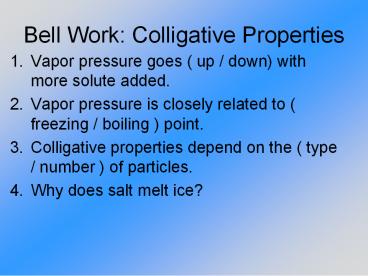Bell Work: Colligative Properties PowerPoint PPT Presentation
1 / 19
Title: Bell Work: Colligative Properties
1
Bell Work Colligative Properties
- Vapor pressure goes ( up / down) with more solute
added. - Vapor pressure is closely related to ( freezing /
boiling ) point. - Colligative properties depend on the ( type /
number ) of particles. - Why does salt melt ice?
2
- Remember The more solute particles that
are in the solution, the more the colligative
properties are affected!
3
Lets Summarize
- Ionic Compounds will dissociate and produce
electrolytes that are capable of conducting an
electric current - The following solutes are placed into water.
What happens to these solutes as they begin to
dissolve?
4
They dissociate into
2 moles of ions
- NaCl ?
- MgCl2 ?
- Na3PO4 ?
1 Na1 1 Cl-1
1 Mg2 2 Cl-1
3 moles of ions
3 Na1 1 PO4-3
4 moles of ions
5
- Q Which substance above produces more solute
particles in solution?
A Na3PO4 therefore, it will have the most
influence on colligative properties
Remember A colligative property depends on
the number of solute particles in solution, not
the identity of the particles
6
- Covalent solutes dissolve, but they do NOT
dissociate into ions. Why? - They do NOT have regions of opposite charge to
attract to the nonpolar solvent!
7
- Instead, covalent substances dissolve as whole
molecules. - The whole molecules form nonelectrolytes and they
DO NOT conduct an electric current!
8
nonelectrolyte
9
- The solutes below are placed into
- water. What happens to these
- solutes as they begin to dissolve?
- C6H12O6 ?
- C12H22O11 ?
- They dissociate one molecule at a
- time!
1 mole of particles
1 C6H12O6
1 C12H22O11
1 mole of particles
10
- Q Which covalent substance above
- would have the most influence on
- colligative properties?
A Neither! They would have the same effect
b/c each covalent compound produces only ONE
mole of solute particle and colligative
properties depend on the number of particles!
11
Lets Summarize
- Covalent Compounds will dissociate into only one
mole of particles and produce nonelectrolytes
that are NOT able to conduct an electric current!
12
- Now its your turn!
- Why do ionic compounds more strongly affect
colligative properties than covalent compounds? - Ionic compounds always dissociate into two or
more particles while covalent compounds always
dissociate into only one! Since colligative
properties depend on the NUMBER of particles, and
ionic compounds produce more particles, they
affect colligative properties more!
13
How does the addition of a solute affect each of
the 3 colligative properties?
- Vapor pressure decreases with addition of solute
to solvent! - There are solute particles interfering with the
solvent particles at the surface of the solution.
- Less of the solvent can evaporate and push
upwards b/c the solute is at the surface, too. - Since less solvent is evaporating, vapor pressure
drops b/c there is not gas pushing upwards.
vapor pressure
14
Vapor Pressure of a Solution A Colligative
Property Which flask has a lower vapor pressure?
Explain. Flask A Flask B Pure
Solvent Solution (no solute present)
Solute Solvent
15
How does the addition of a solute affect each of
the 3 colligative properties?
- Boiling point elevates (increases) with addition
of a solute to a solvent. - For a substance to boil, atmospheric pressure
pushing down must equal vapor pressure pushing
up. - Solute particles interfere with the solvent
particles at the surface.
16
- It will take more energy to get the solvent
particles to push their way to the surface to
evaporate. - This means you have to heat the solution up to a
higher temperature to give the solvent particles
more energy to increase vapor pressure.
17
How does the addition of a solute affect each of
the 3 colligative properties?
- Freezing point depresses (decreases) with
addition of solute to solvent. - Solute particles are mixed in with the solvent
particles interfering with the ability of solvent
particles to get close together.
18
- The solute is in the way.
- This means temperature has to drop A LOT for the
solvent to push the solute out of the way in
order to get close together and solidify.
19
Ionic Compounds
Covalent Compounds
nonpolar (no oppositely charged poles)
polar (have and regions)
since no ions, they dissociate one particle at a
time
dissociate into two or more particles at a time
ions are called electrolytes
no ions so they are called non-electrolytes
conduct electricity
non-conductors of electricity
strongly affect colligative properties
more weakly affects colligative properties

